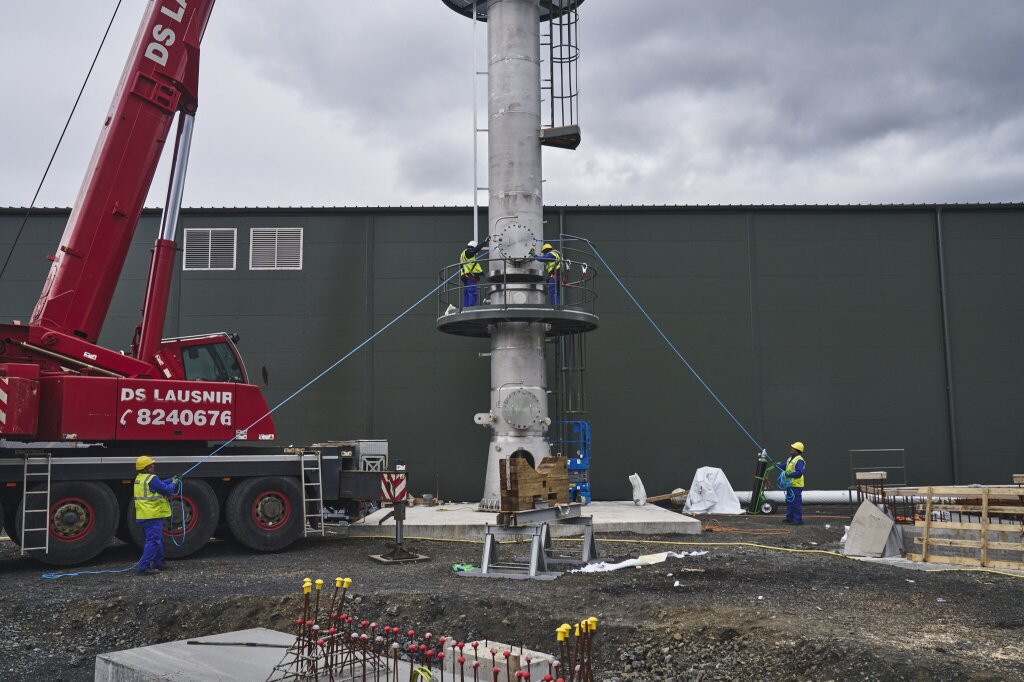Mammoth, Climeworks' latest direct air capture and storage (DAC+S) plant currently under construction, is making steady progress in Iceland. Mammoth represents a demonstrable step in our scale-up roadmap, moving Climeworks’ nominal capture capacity from thousands of tons to tens of thousands of tons per year, keeping us on track to megaton capacity by 2030 and multi-megaton across locations shortly thereafter.
Mammoth’s DAC+S process includes a new feature: the CO₂ absorption tower, developed by Carbfix, owned and operated by Climeworks
Mammoth’s groundbreaking took place in the summer of 2022. Since then, steady progress has been made:
Now another key component of Mammoth has been added to the site: the CO₂ absorption tower. Inside the tower, the CO₂ captured by Mammoth is dissolved in water, which is delivered by Climeworks to Carbfix for underground mineralization. This differs from the DAC+S process implemented at its predecessor, Orca, where Climeworks delivers pure CO₂ in gaseous form to Carbfix, which is dissolved in water underground.
The delivery of CO₂ dissolved in water, instead of gaseous CO₂, makes Mammoth's process less energy-intensive, relying only on medium-pressure compression rather than the energy-demanding liquefaction of the CO₂. This both simplifies and streamlines the process, as well as strengthens Mammoth's resilience to operational variations.
The tower was designed by Climeworks’ CO₂ mineralization partner Carbfix, and as owner of the tower’s intellectual property, Carbfix has a patent pending on the technology used inside. As project owner, Climeworks paid for the construction of the tower and thereby owns it as part of the Mammoth plant. The tower is a testament to the close and highly efficient collaboration between the two companies, as well as representing both innovation and optimization of the DAC+S process and a new infrastructure addition compared to Climeworks’ Orca plant.
Driving learnings thanks to deployment-led innovation
The absorption tower is just one example of how the deployment of first-of-a-kind plants under real-life conditions can drive innovation. Orca, Mammoth’s predecessor, and the world’s to-date only commercial DAC+S plant, allowed Climeworks to gather invaluable field experience, which continually informs Mammoth’s design and construction as well as next projects across locations and at various stages of development, including in the United States.
Further examples of how Orca influenced Mammoth’s design are:
The collector containers (short: CCs) will be installed over a longer period of time to optimize the design and installation before a total of 72 CCs are in place.
While 72 CCs will be in operation, 3 spare CCs will always be ‘on hold’ for maintenance requirements.
Mechanical improvements inside and outside the CCs were made to further optimize the adsorption/desorption process and increase their robustness in the harsh weather conditions in Iceland.
Compared to Orca, Mammoth’s CCs are placed in a V-shaped form to improve the airflow.
We were able to decrease the land requirement per captured ton of CO₂ compared to Orca by adding another level to our stack of CCs.
Mammoth will have a maintenance hall on-site, which will have a threefold impact: increase Mammoth’s overall availability, improve its maintainability,y and thereby reduce operational costs.
Mammoth will have two Carbfix injection wells onsite, whereas at Orca, several hundred meters of CO₂ pipelines had to be installed to transport the CO₂ to Carbfix’s storage site.
Just like for Orca, we expect crucial learnings to be generated through operating Mammoth, which will in turn inform our mission to achieve megaton capacity by 2030, and ultimately gigaton by 2050.
The manufacturing, installation, operation, and maintenance of 72 CCs (compared to 8 CCs at Orca) is a significant step up for our teams, which more than doubled in size to total over 350 Climeworkers between Orca commissioning and now, and will help us gain further significant field experience.
A plant of Mammoth’s scale can, moreover, accelerate the development of the supply chain. Currently, a supply chain to manufacture CCs for megaton DAC capacity does not exist. This development requires time and the maturation of an ecosystem.
Our journey to gigaton is ambitious, and Mammoth is an important milestone in Climeworks’ current radical scale-up. But it is one milestone of many to come, where with each innovation and deployment, Climeworks reinforces its commitment to leading the DAC industry towards a sustainable future.




